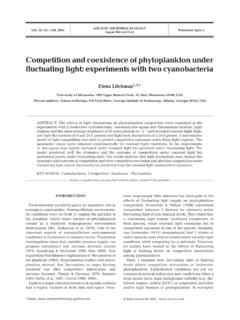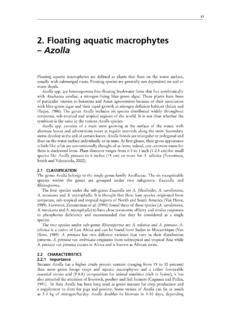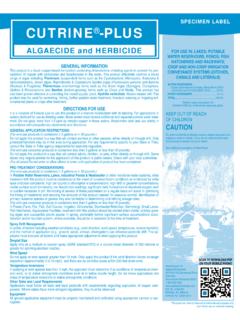Transcription of CHAPTER 8 Algae and cyanobacteria in fresh water
1 136 CHAPTER 8 Algae and cyanobacteria in fresh waterThe term Algae refers to microscopically small, unicellular organisms, some ofwhich form colonies and thus reach sizes visible to the naked eye as minute greenparticles. These organisms are usually finely dispersed throughout the water and maycause considerable turbidity if they attain high densities. cyanobacteria are organ-isms with some characteristics of bacteria and some of Algae . They are similar to algaein size and, unlike other bacteria, they contain blue-green and green pigments andcan perform photosynthesis. Therefore, they are also termed blue-green Algae (although they usually appear more green than blue).Human activities ( , agricultural runoff, inadequate sewage treatment, runofffrom roads) have led to excessive fertilization (eutrophication) of many water has led to the excessive proliferation of Algae and cyanobacteria in fresh waterand thus has had a considerable impact upon recreational water quality.
2 In temper-ate climates, cyanobacterial dominance is most pronounced during the summermonths, which coincides with the period when the demand for recreational water poisonings led to the study of cyanobacterial toxicity, and the chemicalstructures of a number of cyanobacterial toxins (cyanotoxins) have been identifiedand their mechanisms of toxicity established. In contrast, toxic metabolites fromfreshwater Algae have scarcely been investigated, but toxicity has been shown forfreshwater species of Dinophyceae and also the brackish water Prymnesiophyceae andan ichthyotoxic species (Peridinium polonicum) has been detected in European lakes(Pazos et al., in press; Oshima et al., 1989). As marine species of these genera oftencontain toxins, it is reasonable to expect toxic species among these groups in freshwaters as many species of freshwater Algae proliferate quite intensively ineutrophic waters, they do not accumulate to form dense surface scums (often termedblooms) of extremely high cell density, as do some cyanobacteria .
3 The toxins thatfreshwater Algae may contain are therefore not accumulated to concentrations likelyto become hazardous to human health or livestock. For these reasons, this chapterwill focus primarily on the health impacts of cyanobacteria . More detailed coverageof cyanobacteria and human health is available in Toxic cyanobacteria in water (Chorus & Bartram, 1999). Occurrence of toxic cyanobacteriaToxic cyanobacteria are found worldwide in inland and coastal water least 46 species have been shown to cause toxic effects in vertebrates (Sivonen &Jones, 1999). The most common toxic cyanobacteria in fresh water are Microcystisspp., Cylindrospermopsis raciborskii, Planktothrix(syn. Oscillatoria) rubescens, Syne-chococcusspp., Planktothrix(syn. Oscillatoria) agardhii, Gloeotrichiaspp.
4 , Anabaenaspp., Lyngbyaspp., Aphanizomenonspp., Nostocspp., some Oscillatoriaspp.,Schizothrixspp. and Synechocystisspp. Toxicity cannot be excluded for further speciesand genera. As research broadens and covers more regions over the globe, additionaltoxic species are likely to be found. Therefore, it is prudent to presume a toxic poten-tial in any cyanobacterial most widespread cyanobacterial toxins are microcystins and neurotoxins (seesection ). Some species contain neurotoxin and microcystin simultaneously. Fieldpopulations of the most common bloom-forming genus, Microcystis, are almostalways toxic (Carmichael, 1995), but non-toxic strains do occur. Generally, toxicityis not a trait specific for certain species; rather, most species comprise toxic and non-toxic strains. For microcystins, it has been shown that toxicity of a strain depends onwhether or not it contains the gene for microcystin production (Rouhiainen et al.)
5 ,1995; Dittmann et al., 1996) and that field populations are a mixture of both geno-types with and without this gene (Kurmayer et al., 2002). Experience with cyanobac-terial cultures also shows that microcystin production is a fairly constant trait of agiven strain or genotype, only somewhat modified by environmental conditions (seevarious contributions in Chorus, 2001). While conditions leading to cyanobacterialproliferation are well understood (the physiological or biochemical function of toxinsfor the cyanobacteria is the subject of many hypotheses Chorus & Bartram, 1999), the factors leading to the dominance of toxic strains over non-toxic ones , about 60% of cyanobacterial samples investigated contain toxins (seesection ). The toxicity of a single bloom may, however, change in both time andspace.
6 Demonstrations of toxicity of the cyanobacterial population in a given lake donot necessarily imply an environmental or human hazard as long as the cells remainthinly dispersed. Mass developments and especially surface scums pose the Formation of cyanobacterial bloomsIn contrast to true Algae , many species of planktonic cyanobacteria possess special-ized intracellular gas vesicles. Stacks of these minute (<300 nm) proteinaceous hollowcylinders maintain a gas-filled space in the cell, which enables the organism to reg-ulate its buoyancy and thus to actively seek water depths with optimal growth con-ditions. However, regulation of buoyancy by changing the amount of gas in thevesicles is slow. Cells adapted to turbulent mixing by enlarged gas vesicles will takea few days to reduce their buoyancy in order to adapt to more quiescent , especially when the weather changes from stormy to fine ( , mixing condi-tions in the water change from turbulent to strongly stratified), many excessivelyCHAPTER 8.
7 Algae AND cyanobacteria IN fresh WATER137buoyant cells or colonies may accumulate at the surface. Light winds drive them toleeward shores and bays, where they form scums (Figure ). In extreme cases, suchagglomerations may become very dense and even acquire a gelatinous frequently, they are seen as streaks or slimy scums that may even look like blue-green paint or jelly. Such situations may change rapidly, within hours, or may remainunchanged for weeks (Chorus & Bartram, 1999).Scums can be quickly broken by wave action and redispersed by renewed windmixing. However, especially in shallow bays, scum material may take a long time todisperse, as a result of either wave wash or, ultimately, disintegration of the and lysing cells release their contents into the water , where pigments mayadopt a copper-blue colour.
8 Bacterial decomposition leads to rapid putrefaction ofthe material. The in-shore deposits are often repulsive and potentially very agglomerations of cyanobacteria are usually caused by planktonic speciesin eutrophic waters, benthic mats in oligotrophic waters (which are relatively poorin plant nutrients) occasionally also cause problems; these surface-covering mats cangrow only in clear water , in which sunlight penetrates to the bottom. During sunnydays, their photosynthesis may lead to high rates of oxygen production, formingbubbles that loosen parts of the mats and drive them to the surface. Mats of benthiccyanobacteria washed to the shore and scavenged by dogs have been lethal (Edwardset al., 1992), and cattle deaths on Swiss alpine meadows may also be caused bybenthic cyanobacteria (Mez et al.)
9 , 1997, 1998). Although relevant for pets and live-stock, the human health impact of these cyanobacteria on beaches will be consider-ably lower than that of scums in the water . Awareness of the potential toxicity of suchbeached mats is, however, important, because they accumulate along shores of clearwaters usually not recognized as potentially producing harmful cyanobacteria CyanotoxinsProgress in analytical chemistry has enabled the isolation and structural identifica-tion of three neurotoxins with somewhat different modes of blocking neuronal signaltransmission (anatoxin-a, anatoxin-a(s) and saxitoxins), one general cytotoxin, whichinhibits protein synthesis (cylindrospermopsin), and a group of toxins termed micro-cystins (or nodularins, found in brackish waters), which inhibit protein inhibition is generally cytotoxic, but microcystins are primarily hepato-toxic, because they use the bile acid carrier to pass through cell membranes.
10 Thesetoxins were named after the organism from which they were first isolated, but mostof them have been found in a wider array of genera, and some species contain morethan one toxin or both microcystins and the toxins listed in Table are assumed to be the substances most significant for human health, it is unlikely that all of the important cyanotoxins have been discovered. Yoo et al. (1995) pointed out that an increasing variety of in-dividual toxins is continually being discovered. Numerous pharmacological working groups are conducting research for pharmacologically active substances fromcyanobacteria ( , Mundt & Teuscher, 1988; Falch et al., 1995). Fastner et FOR SAFE RECREATIONAL water ENVIRONMENTSCHAPTER 8. Algae AND cyanobacteria IN fresh WATER139 Lake profile4 m4 cmverythickscumBuoyancy leads to 100-foldaccumulation of cellsfetch of wind 100 mLake bird s eye viewdirection of winddirection of windmoderate risk level: 50 g/l chlorophyll-a or 100 000 cells/ml possibly 20 g/l of microcystin in top 4 m of water body100-fold accumulation to high risklevel scum: 5 000 g/l chlorophyll-a or 10 000 000 cells/ml possibly 2 000 g/l of microcystin in top 4 cm of water body1000-fold accumulation if windsweeps scums from 100 m into 10 m.
















